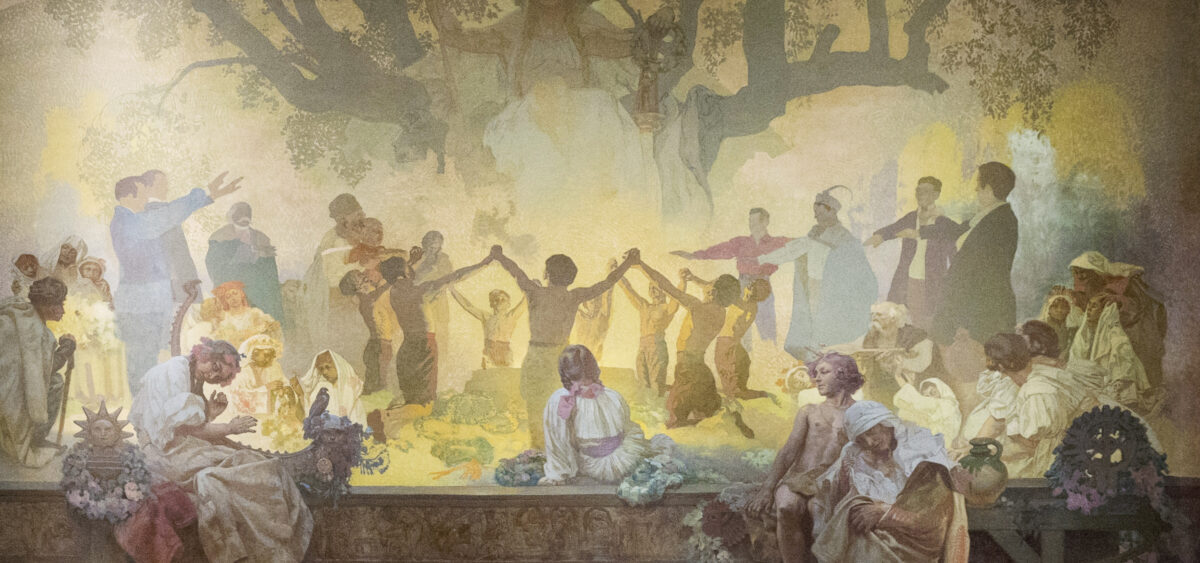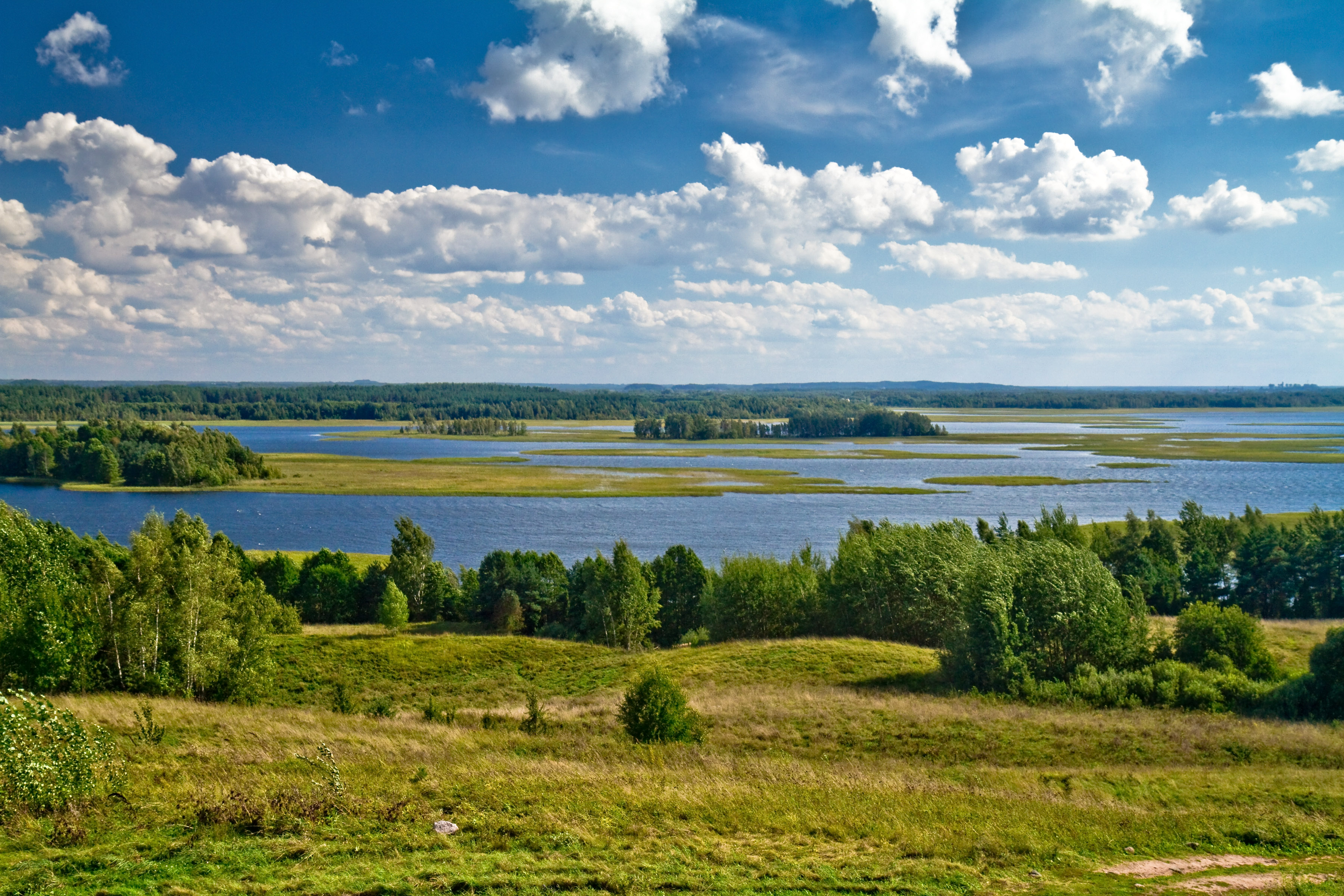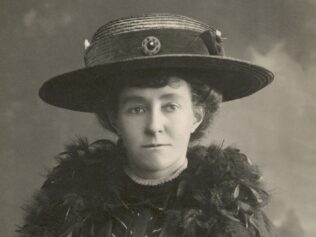
From Gothic folklore to a national manifesto—this is the story of how one mid-19th century Polish book traveled across languages and into the center of the modern Belarusian literary canon, as well as the country’s contemporary politics.
The short stories contained within it are reminiscent of Gogol, Mary Shelley’s Frankenstein, and the Arabian Nights. Over the hills and far away, somewhere on the northwestern borderlands of the Polish imaginary, there once was a happy land. At the very heart of a thick forest, on the edge of an enormous lake “shaped like a limb of the sea,” there is a house, or perhaps even a manor. Every winter night a candle burns in one of its windows. It is something of a beacon for stray wanderers riding on horseback or gliding on sleighs over the frozen lake, which during the winter changes into a wide trail devoid of any orientation points or guideposts. When snowstorms rage, the little flickering flame becomes the only hope for winter travelers, and the house itself—a safe haven. A warm meal awaits those who manage to reach its hospitable threshold, as well as a seat by the fireplace and a good night’s sleep under plump covers. There is one condition, however, set by the host himself: the guest must tell a story, and an engaging one at that. Luckily enough, the silent and the boring are not punished by beheading. Such is the starting point, or, to put it more aptly, the narrative frame of a book that is apparently part of Polish literature, even though few have heard of it in Poland. The work Nobleman Zavalnya, or Belarus in Fantastic Stories was written by Jan Barszczewski and published in four volumes in Saint Petersburg between 1844 and 1846. It could be called a local Decameron, or A Thousand and One Nights crossbred with the Old Polish gawęda, a genre of epic tale. In Nobleman Zavalnya, the role of the sultan thirsting for stories is played by the eponymous hero and host, the Polish Sir Zavalnya. It should be noted, though, that he listens to the stories of a Belarusian Scheherazade, because the tales that are told by the various narrators of the book mostly originate in the remote area of Vitsyebsk in northeastern Belarus, somewhere near Polatsk and Lake Neshcharda, which lies even further to the north (today the Russian border is only three miles away). These lands have been inhabited by the Belarusian people for hundreds of years. This is where most of Sir Zavalnya’s guests come from—among them the coachman, the fisherman Roćka, the blacksmith Auhinia, and the organist Andrzej. Upon arriving at his abode, they serve him his favorite evening meal: hypnotic stories of fantasy or blood-curdling tales of horror that can, if only for a moment, dispel the boredom of long winter evenings in the home of a hermit host.
Author, Author…
Before the book itself is discussed, it is worth devoting some attention to the author, Jan Barszczewski, who in Polish culture seems to have fallen into the same absolute oblivion as his work. He was born in 1790 or 1794 in the village of Morohy, a region that was once referred to as “on Belarus’s eastern border, in the former Polatsk voivodeship.” Just a dozen years before his birth, this area still belonged to the Polish-Lithuanian Commonwealth, and before that to the Grand Duchy of Lithuania. He was educated at the famous Jesuit College in Polatsk, then moved to Saint Petersburg, where he made a living teaching Latin and Greek. In the Russian Empire’s capital he frequented Polish circles. He worked as the editor of the journal Niezabudka where he met the poets and writers Taras Shevchenko and Adam Mickiewicz, the latter of whom allegedly revised his poems. According to his contemporaries, he was a “universally liked original,” and carried “a tan complexion, not a parlor one.” This was probably due to the fact that he returned to his homeland every spring. Ignacy Hołowiński, a man of cloth and letters, described his friend in the following way: “He knew all of Belarus most perfectly since he made his way around it thirty times at least, and even now visits it yearly from Saint Petersburg.” Barszczewski knew the country inside out. He would roam it with a walking stick, feeling most at ease among the commonest people, on the fields of the Daugava, or in wayside inns where the most interesting stories could be heard. He was unhappy in Saint Petersburg, and this feeling found its way into the sorry poems he included in the numerous volumes of Nobleman Zavalnya—the speaker pines for his motherland and greatly suffers on the stone banks of the Neva River, tormented by the heavy northern auras and gales. Even so, it was in Saint Petersburg that Barszczewski wrote his magnum opus. Unfortunately, it never achieved the success he expected. Subscribers were not interested in the later volumes of the work. Towards the end of his life, Barszczewski moved to Volhynia (today in western Ukraine) where he died, completely forgotten, in 1851.
A Borderlands Fantasy
The guests’ stories in Nobleman Zavalnya likely reflect what terrified and upset people living on the Belarusian borderlands in the first half of the 19th century. Typical fairy-tale tropes multiply endlessly: witches and wizards, buried treasures abandoned by dragons (marked, for instance, by a large rock on the hill near the village), a challenging quest for the crown of the King of Snakes. People miraculously morph into animals (and vice versa), there is the cat Vargin, the demon Nikitron, fiery spirits, and the Leshnik—a Belarusian forest deity who guides animals through the woods. Some tales also include Master Twardowski, popular in the Polish literary tradition. Space in these stories seems equally magical and doesn’t necessarily correspond with contemporary notions about the northern Belarusian landscape. It is replete with high mountains, steep precipices, and desolate areas. As one of the narrators puts it, “this expanse is criss-crossed by narrow rocky paths that cut through mountainous regions and, passing by the wild banks of various lakes, hide away in the woods.” The most interesting stories the Polish nobleman hears are concerned with unexplained phenomena or strange states that befall the characters. One of these embedded narratives is the confession of a man who changes into a werewolf under the influence of enchanted vodka. He roams forests and mountains “in the form of a terrible animal,” taking revenge on people, but eventually returns to the bosom of his community after hearing a preacher’s sermon. The role of clergy and the Church turns out to be extremely important in the folk worldview represented by various narrators. Priests are usually authority figures and the last best hope, as they have mastered all of the practical ways to fight evil (mostly through prayer)—and the wickedness and illnesses that befall people are usually caused by the plotting and scheming of malevolent forces. The demons themselves—they appear whenever they are called for—often inhabit remote places, such as isles on lakes devoid of fish. Sometimes, as goes the Belarusian saying “In silent swamps the devil spawns,” they nest in little muddy lakes in the middle of the forest. When fishermen cast their nets in such places, they fish out entire swarms of these small creatures (“resembling lobsters covered in black fur, and others like spiders the size of cats”). It seems these horrors are encouraged to spawn when a lord refuses the priest’s blessing of his lake. Sometimes the devil adopts a thoroughly modern form and dresses in European garb, remaining equally dangerous in its disguise. The demon Nikitron, for example, appears in a red robe and is described by the narrator as resembling “a huge Black man.”
Blind Spots
An important element, which appears to scarcely require comment in the world of Nobleman Zavalnya, is serfdom and the complementary patriarchal social system. It is mentioned as if in passing and is embodied by nameless lords who always require something, arrange weddings for peasants, force fishermen to attempt dangerous catches, sometimes even conspire with dark forces. In this reality people simply get up at dawn and start their daily share of free work on their lord’s land—as if it were the most obvious thing ever—and on their way to work they see the devil with his legs crossed, playing the bagpipes on the surface of a lake. Indeed, only the devil is surprising enough to require some kind of explanation. Feudalism and the hierarchical, violent social system remain something of a blind spot in the mindset of the main narrator Zavalnya. They are simply part of the natural and unquestioned order of things. The mythical “golden era” of the past which the narrator longs for also bears traces of this order, even though its end was brought about by—as the reader learns—the desire for riches and oppression of the poor. Ever since the “golden era” came to an end, humanity has been persecuted by God’s punishment: natural disasters and bad harvests. In Zavalnya’s world, the past is idealized—by a nobleman who is the owner of land and souls—because the near future is a source of fear. He tells the story of a lord who decided to build a factory and thus brought the traditional agricultural economy to ruin, forcing his peasants into poverty. It serves as a general cautionary tale about modernity with its devilish inventions such as industrialization. The passage ends with a eulogy to the fathers—good masters who generously give out food to their miserable serfs and neighbors whenever crops fail.
A Year Without Summer
Apart from large doses of local fantasies, Nobleman Zavalnya also includes some interesting material for literary scholars. An important part of the book’s universe are memories of numerous natural disasters and other catastrophes that have continued to affect these lands and their inhabitants in a truly fatal way. In her paper “Koniec świata, którego nikt nie zauważył” [The End of the World that No One Noticed], Iwona Węgrzyn argues that bits and pieces of information scattered throughout the book suggest that the plot is set in the winter months at the turn of the year 1816. The scholar also notes that in Western history 1816 was called the year without a summer. Because of the explosion of the Mount Tambora volcano in Indonesia and the clouds of dust it generated, temperatures dropped considerably throughout the Northern Hemisphere. The cold caused bad grain harvests and famine. The most famous literary testimony of these strange times is Mary Shelley’s Frankenstein, written during that feral summer in the Villa Diodati near the Geneva Lake. “If I’m correct,” writes Węgrzyn, “by comparing Jan Barszczewski’s experience of the year 1816 to that of Byron and Mary Shelley, it wouldn’t be that absurd to call Sir Zavalnya’s manor the Belarusian Villa Diodati […] Maybe the tales that were told within its walls aren’t only literary variations of folk motifs, but also a thoroughly romantic record of the premonitions and concerns people felt in those times.” The motif of the eclipse appears in Nobleman Zavalnya alongside descriptions of other weather anomalies. One of them mentions the so-called pestiferous year that “spread famine and pestilent air in all of Belarus,” describing how “the Earth was devoid of snow, the mountains were stripped of grass and resembled infertile rock, the northern winds blew over the naked fields as if they were sandy steppes and brushed away the scorched soil, killing the rye seedlings with their murderous breath; the earth cracked and broke up in the terrible cold while fish were smothered by unnaturally thick layers of ice that covered the lakes.” Other sources mention strange events related to the so-called rowan night: “[…] a time of battle between good and evil, when the violent August storms that filled the sky with thunder and blinding lightning were taken as signs of struggle between the forces of heaven and hell, as well as a decisive moment for the survival of crops.” Also significant in the book are descriptions of strange atmospheric phenomena, bloody or fiery sunsets, and, most importantly, incredible cloud formations resembling buildings, fortresses, or entire armies of mounted knights clashing in battle. For the author, they symbolically anticipate future events: “[…] read these signs set in the ever-changing shapes of the swimming clouds that always rest above your eyes; God’s hand traces its warnings there, that nothing solid exists on earth; power, wealth, honors, and fame will fade and disappear like thin smoke in the air.”
Barszczewski Versus Gogol
The use of local folk tales in a book written in the language of a different culture may bring to mind a certain work of the same period that is considered part of the Russian literary canon—Nikolai Gogol’s short stories, published in the collections Evenings on a Farm Near Dikanka and Mirgorod. These stories, written in Russian between 1829 and 1832, were the debut of a writer who came from eastern Ukraine (Gogol was born into a noble Ukrainian family near Poltava, between Kyiv and Kharkiv). Like Barszczewski in Nobleman Zavalnya, Gogol created literary adaptations of the often fantastical folk stories he had heard—in this case, stories rooted in Ukrainian folk culture. Along the way, he authored true classics of gothic folk literature, such as the uncanny Centipede and The Enchanted Place. What makes all the difference between Gogol and Barszczewski is the unparalleled literary talent of the former, which had already reached its mature form in those early works (even before the Saint Petersburg tales) as a mix of an incredible sense of observation and realism, as well as humor and irony. The Polish scholar of Romanticism Maria Janion emphasized that irony was almost entirely absent from Barszczewski’s works (“alien to the people, threatening moral clarity, it would have been very dangerous”). In its place, the Polish works have a slightly boring kind of moralism (Zavalnya often sums up the stories he relates with trite comments about alcoholism and impudent actions), which nonetheless falls in line with the traditionally conservative folk mindset. All the same, one may speak of two quite similar and in many ways parallel gestures of cultural colonialism. Both cases are instances of the dominant culture’s vampirism—the Russian and Polish writers collect material and vital energy from the local folk cultures (respectively, Ukrainian and Belarusian) to write works in the languages of their own (or adopted) cultures. The final difference between the authors lies in the historical effectiveness of these gestures. While Gogol’s remarkable talent played its part in popularizing Russian literature abroad (and blurring Ukraine’s separateness along the way), Barszczewski’s works—of lower literary quality and closer to the folk spirit—occupied a marginal place in Polish literature, not to mention world literature. Paradoxically, this artistic “mediocrity” and loyalty to folk culture allowed Barszczewski to create a testimony, unlike Gogol. Iwona Węgrzyn argues that “through his fantastical stories inspired by Belarusian folklore, Barszczewski recounts the fears experienced by the community—knowing that a familiar world is falling into oblivion and dreading what the future might bring. These stories exude the people’s sense of an omnipresent danger.” For this reason, Barszczewski’s book still had an incredibly important yet completely unexpected role to play in the history of literature.
A Hotbed of National Literature
Nobleman Zavalnya wasn’t reprinted in Poland until 2012, which suggests that the book never really entered the Polish consciousness. For researchers and critics it remained a lesser work of the so-called Belarusian (northern) school of Polish Romanticism. The average reader didn’t know most of Barszczewski’s stories, apart from those that occasionally appeared in anthologies, such as “Hair Screaming on the Head,” included in Julian Tuwim’s anthology of short fantasy stories Polish Fantasy Novella (1949). Meanwhile, Barszczewski’s oeuvre played an entirely different role in Belarusian literature. Although it was written in Polish, it became a cornerstone of Belarusian national literature for many local writers and scholars, while the author himself was described as “the first 19th-century Belarusian writer” (alongside other Polish contemporaries of noble birth: Alexander Rypiński and Jan Czeczot). In the book’s preface, the fictional editor of the work explains that: “Because not all readers would be able to understand the Belarusian language, I decided to present these stories, which I had originally heard from the mouths of the people, in literal translation into Polish, which was done to the best of my abilities,” thus suggesting that the stories in their original form were essentially Belarusian. As a result, certain Belarusian authors, including Maksim Harecki, called for a retranslation of the pieces “into their maternal tongue, because they are very Belarusian and the foreign form is detrimental to them.” Harecki and many others wanted to present Nobleman Zavalnya as an original testimony of Belarusian folklore, a work that belonged to oral folk culture. The latter point was rather unpopular with folklorists and ethnographers, among them the greatest specialist on Belarusian folk culture, Michał Federowski, who described the book as “a handful of tales from the Vitsyebsk region severely twisted by literary adaptation.” Even so, the contemporary Belarusian literary scholar Michaś Skobla does not doubt the national identity of Barszczewski’s work: “When his book is read in Belarusian, it’s impossible to notice it has been translated from another language. It’s also blatantly obvious that the stories were written in Belarus,” he argues. The sheer number of translations and editions of Nobleman Zavalnya testifies to the book’s popularity in Belarus—throughout the 20th century as many as a dozen Belarusian translators worked on Barszczewski’s magnum opus. However, the first edition was only published in 1990, when Mikalaj Khaustovich’s translation came out in Minsk. According to this scholar, who is also the author of the bilingual Polish-Belarusian edition of the work, Barszczewski was the first author to consciously use the name “Belarus” in his writings, contrary to Mickiewicz or the Philomath society (who used the historical name “Lithuania” even though they basically wrote about the same area). In the preface to his translation of the book, Khaustovich writes that Barszczewski laid the cornerstone for the existing national literary myth of Belarus, built around the following elements: Belarus is a country that has its own history; its past is happier than its present; its people are a separate nation that should be able to live independently, free from their neighbors’ dictate, in accordance with the laws and traditions of their ancestors, and not the customs and habits of other nations. Khaustovich claims that Barszczewski’s text—more than any other poem, hutarka [a literary genre based on the form of a dialogue, common in Belarusian literature—Ed.], or longer work written in Belarusian—stimulated the development of national literature by influencing the works of Vintsent Dunin-Martsinkyevich, Arciom Viaryha-Dareuski, Janka Bryl, and many others. “Enriching the national literature became the responsibility of younger generations of Belarusian writers. It was easier for Barszczewski’s followers to navigate the national spirit once they could see the contours of the Belarus he had marked out,” concludes the scholar.
Current Political Drama
The Polish book written more than 150 years ago finally met its own perfectly contemporary reception in 2019, when the Janka Kupala Theater in Minsk staged a play based on Nobleman Zavalnya. Despite the fact that the play was performed in the most important governmental institution of the authoritarian Republic of Belarus, it managed to carry a clear if subversive political message. According to Vasil De Em, a reviewer from the Radio Svaboda website, the main topic of the script created by playwright Siergiej Kovaliov was meant to be the threat of Russian occupation, which was quite literally expressed on stage. One of the fantastical characters in the play, the ominous White Magpie, speaks Russian with a German accent: a clear reference to Catherine the Great (who personifies Russia). The main characters, Sir Zavalnya and his nephew, try to fight her, the demon Nikitron, and other monsters from Barszczewski’s enchanted universe. The reviewer compared the aesthetics of the play to performances from the 1920s, a brief period of creative freedom and artistic experimentation in Soviet Belarus. It abruptly ended after a violent crackdown against national culture, purges, and the annihilation of the Belarusian intelligentsia. The reviewer concluded his piece by emphasizing that the unique work of director Alena Ganum has a “long stage life ahead of it, one which could probably only come to an end […] with the real occupation of Belarus by Russia, which we hope will never happen.” He wrote these words in July 2019. A year later, in the summer of 2020, some sources suggested that the presidential elections in Belarus had been rigged, causing mass demonstrations that the government cracked down on with brutal force. After Paviel Latuška was fired from his role as director of the Kupala Theater, its employees joined the protests and most of them quit their jobs afterwards in solidarity with him. The threat of “real occupation” became an even greater possibility in February 2022, when Russia invaded Ukraine. Since then Russian troops have been stationed in Belarus, and the darkest scenario presented in the theatrical adaptation of Barszczewski’s book seems to be materializing before the region’s eyes.
Life After Life
However, if the story of Nobleman Zavalnya teaches readers anything, it is that hope should never be lost, the ways of history can never be foreseen, and the traces of a national spirit cannot be eradicated. What could seem dead many times over may simply be dormant or thriving in the shadows—and one never knows when it will bloom and flourish. The discovery in spring 2019 of Jan Barszczewski’s tombstone in Chudniv, Ukraine—where the writer died 170 years earlier—can be considered a symbolic return from the dead. A Ukrainian girl found the tombstone near her house and translated the Polish inscription. Since her discovery, the tombstone paid a brief visit to the Belarusian hometown of the writer, and a statue commemorating his work was unveiled in Chudniv in September 2020. The journey of Nobleman Zavalnya and its author to the center of Belarusian culture has been long and bumpy, and remains unfinished to this day. Even so, there is no doubt that the true seeds of the country’s culture—whose very nature is the right to self-determination and independence of its people as a nation—once sown by a Polish nobleman from Polatsk, are still alive and their mission remains to be completed.
The following sources were used while researching this article: the bilingual edition of Nobleman Zavalnya, edited and with an introduction by Nikolai Khaustovich; as well as articles by Maria Janion (“Jan Barszczewski”) and Iwona Węgrzyn (“Koniec świata, którego nikt nie zauważył. Białoruski ,rok bez lata’ Jana Barszczewskiego” [The End of the World that No One Noticed: The Belarusian “Year Without Summer”].










